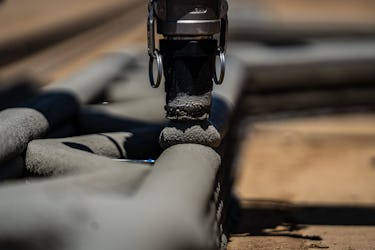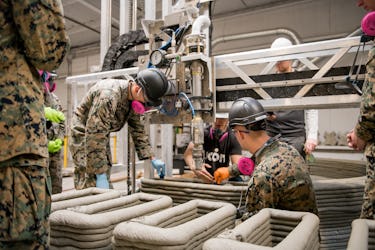United States Marine Corps and ICON 3D Print Structure at Camp Pendleton
Eight Marines Trained to Use ICON's Tech to 3D Print a Structure.
Over the past year, the ICON team has been working with the Defense Innovation Unit (DIU), an organization that focuses on accelerating commercial tech into the Department of Defense (DoD), to demonstrate the use of commercial-scale additive manufacturing for military use.
“There are commercial technologies that provide one area of excellence in robotic building, but few that tie all the necessary aspects together in a way that makes construction instantly accessible to the novice without any software engineer training,” said Jeremiah Diacogiannis, DIU program manager, U.S. Navy Lt. “The design of new structures, from shelters to bridges, can be done in less time and with fewer hands via simple, intuitive commands on a touchscreen tablet or smartphone and executed by the robotics system at the push of a button.”

DIU has been working with the USMC to leverage a commercial technology in Construction Scale Additive Manufacturing for military use and in the future, to scale across the Services to provide a rapid and expeditionary construction capability. This will simultaneously support military operations and crisis response efforts around the globe.

ICON has been prototyping various structures with DIU and USMC utilizing technology that combines 3D robotics, software and advanced material. In January 2020, Marines were trained on the software, robotics and material delivery sub-systems at ICON’s lab with the goal of a future field demonstration to build structures important for expeditionary construction.

After the successful training session, the teams embarked on a journey out of the lab and into the field to 3D print and stand up a Vehicle Hide Structure at Camp Pendleton.
With only a few hours of field training and shadowing ICON operators on site, the Marines took over as the primary operators of the equipment from start to finish during printing. The technology provides tablet-based system controls that allow even brand-new operators to deliver high-quality printing.

At the onset of the project, the goal was to complete the print in 40-48 hours, with some expected loss of productivity for troubleshooting while getting the Marines up to speed. Some recent automation upgrades that increased the precision of the material delivery system paid huge dividends, and the print was completed in 36 hours with virtually zero troubleshooting time.

“We were thrilled to have the opportunity to hand over the controls of our technology to the USMC. This marked the first time non-ICON employees were the primary operators of our equipment and they did an incredible job printing the Vehicle Hide Structure,” said Michael Harper, Director of Field Operations for ICON. “After getting a glimpse of what 3D printing can accomplish, the Marines had great ideas for other applications of this technology, and we can’t wait to assist in making those ideas become a reality.”

PROJECT STATS:
Tech: ICON’s Vulcan 3D printer weighs 3800 pounds and can print up to 2,000 sq ft In 2019, the Vulcan printed 400-500 square foot homes in Mexico and the U.S.
Structure: 4 arches were 3D printed, then titled to create a vehicle hide structure at 26’ length x 13’ width x 15’ height
Speed: Vehicle hide structure print took 3 and a half days and ~ 36 hours of print time (continuous printing to completion capability exists if enabled to work in shift rotations throughout a 24-hour day)
Material: Lavacrete is a proprietary, cement-based material with a PSI of 2,000 - 3,500
Crew: 8 Marines were trained on ICON’s Vulcan and Magma operations with 3-4 actively involved in rotations at a time

“The unique opportunity to provide cutting-edge tools to improve the mission capabilities of the Marine Corps and watch them take the reins with the technology this past month makes us proud,” said Dmitri Julius, VP of Operations at ICON. “As a retired USMC Veteran, I am honored to work with this storied organization. Our desire is to have a continued long-term partnership to put 3D printers in the hands of Marines in garrison and down range. The humanitarian applications are also endless and the ability to build useful structures for our bravest service men and women is truly tremendous.”
See the project in action: